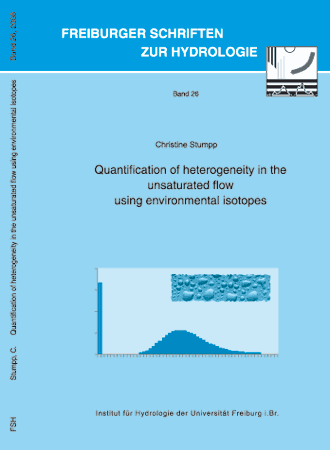|

Freiburger Schriften zur Hydrologie
 |
[ << Band/volume 25 ] [
Freiburger Schriften zur Hydrologie ] [
>> Band/volume 27 ]

Band/volume 26: Stumpp C. (2008):
Quantification of heterogeneity in the unsaturated flow using environmental isotope
 Knowledge about soil water transport and groundwater renewal rates is crucial for groundwater research and risk assessment. Particularly the impact of preferential flow paths in the unsaturated zone on pollutant transport is an important topic, as it affects the vulnerability of the adjacent aquifer. However, in literature the determination of preferential flow is only partly solved and especially quantification attempts have been rare. Therefore, a new method combining mathematical modelling with hydrological and environmental isotope data was developed to estimate the heterogeneity of the unsaturated transport processes. Knowledge about soil water transport and groundwater renewal rates is crucial for groundwater research and risk assessment. Particularly the impact of preferential flow paths in the unsaturated zone on pollutant transport is an important topic, as it affects the vulnerability of the adjacent aquifer. However, in literature the determination of preferential flow is only partly solved and especially quantification attempts have been rare. Therefore, a new method combining mathematical modelling with hydrological and environmental isotope data was developed to estimate the heterogeneity of the unsaturated transport processes.
For this purpose, environmental isotope transport (18O, 2H) was investigated in several lysimeter experiments. A conceptual model was applied, which separates preferential and matrix flow. Both flow components are quantified and their transit time distribution functions are determined to construct specific vulnerability diagrams.
Water flow and transport of environmental isotopes through the soil matrix was calculated using both a transient modelling approach solving numerically Richards and Convection-Dispersion-Equation for single porous medium and a lumped parameter approach using the Dispersion Model. The preferential flow component is assumed by piston flow occurring within one week and having no interaction with the soil matrix.
For quantification a two component flow approach was applied to the isotope and hydrological data. The mean transit time distribution functions were obtained from the lumped parameter approach and visualized in specific vulnerability diagrams, showing when infiltrating water reaches the groundwater. This method was applied to different lysimeter experiments that were conducted under natural atmospheric conditions. Different lysimeters, filled mostly with sandy soil material, were under investigation to study the impact of soil properties and vegetation on the transport heterogeneity and amount of preferential flow.
It was shown that the lumped parameter approach yielded good results modelling the isotope transport in the soils with bare surface. An application to the soils with vegetation required a modification of the classical input function including evapotranspiration and thus considering the infiltration events contributing to the discharge. Additional separation into the single vegetation periods improved the modelling.
Preferential flow was observed in all soils and quantified with the two component flow approach. In bare sandy and gravel soils the mean fractions of preferential flow varied between 17 and 30 %. Here, the crucial parameter influencing these fractions was found to be the saturated hydraulic conductivity. In the cropped soils the mean fractions of preferential were dependent on the discharge rate and varied according to the vegetation. Mean fractions of 3 % and 18 % were observed in a loamy sand during intercrop period and cultivation of maize monoculture, respectively. The same soil material but cultivated with crop rotation yielded mean fractions of 14 % during maize, 4 % during winter barley and 15 % during the intercrop vegetation period. In a third experimental setup with sandy soil a mean fraction of 8 % was found.
Specific vulnerability diagrams were constructed showing the mean transit time distribution functions of both, preferential and matrix flow. Their patterns were closely related to soil parameters. They can be used as a helpful tool to develop groundwater protection strategies more efficiently.
It was shown that the presented method enabled the estimation of transport heterogeneity and the quantification of preferential flow under natural atmospheric conditions in bare and cropped lysimeters using environmental isotope data. Such isotopes are adequate tracer to study the transport processes in the unsaturated zone. It was revealed that experiments with continuous natural application like environmental tracers over long time periods were necessary to cover a broad range of flux variability and to determine transport heterogeneity.
[ deutsche Zusammenfassung ]
|

